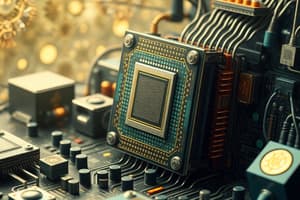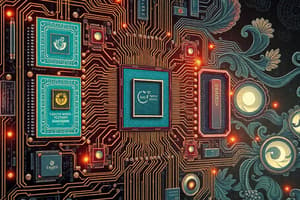Podcast
Questions and Answers
What describes the trend of increasing transistor density on computer chips?
What describes the trend of increasing transistor density on computer chips?
- Babbage's Theory
- Turing's Hypothesis
- Moore's Law (correct)
- Einstein's Principle
Which of the following is NOT a common type of network?
Which of the following is NOT a common type of network?
- Wide Area Network (WAN)
- Global Distributed Network (GDN) (correct)
- Local Area Network (LAN)
- The Internet
What is one major impact of technological advancements in computing?
What is one major impact of technological advancements in computing?
- Personal computing has decreased in popularity
- Computers are now available only in large sizes
- Computers have become smaller and faster (correct)
- Computing is slower and more inefficient
Which area is NOT emphasized for future advancements in computing?
Which area is NOT emphasized for future advancements in computing?
What drives continual research and development in computing?
What drives continual research and development in computing?
What is the primary function of the Central Processing Unit (CPU) in a computer?
What is the primary function of the Central Processing Unit (CPU) in a computer?
Which type of computer is specifically designed for tasks like graphic design and video editing?
Which type of computer is specifically designed for tasks like graphic design and video editing?
Which statement best describes the role of an operating system?
Which statement best describes the role of an operating system?
What do the terms 'bits' and 'bytes' refer to in computer data representation?
What do the terms 'bits' and 'bytes' refer to in computer data representation?
What is the main function of input devices in a computer system?
What is the main function of input devices in a computer system?
Which of these is a common type of application software?
Which of these is a common type of application software?
What distinguishes a server from a personal computer?
What distinguishes a server from a personal computer?
How do computers typically represent data?
How do computers typically represent data?
Flashcards
Local Area Network (LAN)
Local Area Network (LAN)
A network connecting devices within a limited physical area, typically a building or home.
Wide Area Network (WAN)
Wide Area Network (WAN)
A network connecting devices across a wider geographical area, spanning cities, countries, or continents.
Internet
Internet
A global network of computers and other devices, enabling communication and information sharing.
Moore's Law
Moore's Law
Signup and view all the flashcards
Artificial Intelligence (AI)
Artificial Intelligence (AI)
Signup and view all the flashcards
What is the CPU?
What is the CPU?
Signup and view all the flashcards
What is RAM?
What is RAM?
Signup and view all the flashcards
What is software?
What is software?
Signup and view all the flashcards
What is an operating system?
What is an operating system?
Signup and view all the flashcards
What is a computer network?
What is a computer network?
Signup and view all the flashcards
What are input and output devices?
What are input and output devices?
Signup and view all the flashcards
What is data representation in computers?
What is data representation in computers?
Signup and view all the flashcards
What is storage?
What is storage?
Signup and view all the flashcards
Study Notes
Definition and Components
- A computer is a programmable electronic device that can store, retrieve, and process data.
- Key components of a computer include the central processing unit (CPU), memory (RAM), storage (hard drive, SSD), input devices (keyboard, mouse), and output devices (monitor, printer).
- The CPU is the "brain" of the computer, performing calculations and executing instructions.
- RAM (Random Access Memory) is used to store data that the CPU is currently working with, allowing for fast access.
- Storage devices, like hard drives and SSDs, hold data even when the computer is turned off.
- Input devices allow users to provide instructions and data to the computer, while output devices display results.
Types of Computers
- Personal computers (PCs) are designed for individual use and come in various form factors like desktops and laptops.
- Workstations are more powerful computers designed for specific tasks like graphic design, video editing, or scientific computing.
- Servers are powerful computers designed to provide services to other computers on a network.
- Embedded systems are computers built into other devices, like smartphones, cars, and appliances.
Operating Systems
- An operating system (OS) is software that manages computer hardware and software resources.
- Common operating systems include Microsoft Windows, macOS, Linux, and Chrome OS.
- The OS provides a user interface for interacting with the computer and manages tasks like running applications, managing files, and controlling peripherals.
Software
- Software consists of the set of instructions that tells the computer what to do.
- System software includes the operating system and utilities to manage the computer's resources.
- Application software includes programs for specific tasks such as word processing, web browsing, and video games.
Data Representation
- Computers use binary code (0s and 1s) to represent data, performing operations and managing memory accordingly.
- Data is represented as bits and bytes, and this is crucial for the function of hardware and software in a computer.
- Different ways to represent data, such as text, numbers, images, and sounds, need to be translated to this digital format.
Computer Networks
- A computer network is a system of interconnected computers that can communicate and share resources.
- Networks enable communication and data sharing between various devices and systems, forming a connected environment.
- Common types of networks include local area networks (LANs), wide area networks (WANs), and the internet.
History of Computing
- The history of computing spans several decades, starting with mechanical calculators and progressing significantly to today's powerful personal computers.
- Early computers were large, bulky machines used for calculation and other tasks.
- Technological advancements have led to smaller, faster, and more powerful computers.
- Moore's Law describes the trend of increasing transistor density on computer chips, leading to improved processing power.
Future of Computing
- Advancements in computing continue to explore fields like artificial intelligence, cloud computing, quantum computing, and more.
- These fields are focused on incorporating advanced technologies and improving the capabilities and accessibility of computing systems.
- Increased speed, efficiency, and new uses are major drivers for continual research and development.
Studying That Suits You
Use AI to generate personalized quizzes and flashcards to suit your learning preferences.




